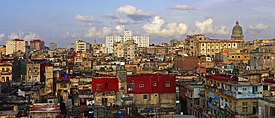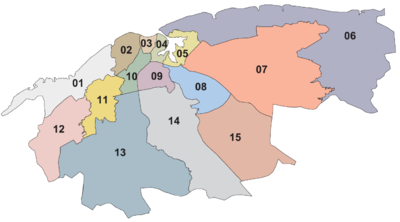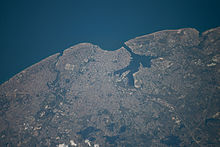Havana
![]()
The title of this article is ambiguous. For other meanings, see Havana (disambiguation).
Havana (Spanish La Habana), full name Villa de San Cristóbal de la Habana, is the capital of the Republic of Cuba and also an independent province. With about 2.10 million inhabitants and an area of 728.26 km², it is the second largest metropolis in the Caribbean after Santo Domingo. The city borders the Atlantic Ocean or the Strait of Florida to the north and extends south and west of the Bay of Havana ("Bahía de La Habana"). The Río Almendares River crosses the city from south to north and eventually joins the Florida Strait west of the bay. The bay to the east of the centre is home to the city's three major ports: Marimelena, Guanabacoa and Atarés.
Havana was founded by the Spanish in 1519 due to its strategic location. The city served as a pivotal point from which the further conquest of the Caribbean-Central American region to North America by the Spanish took place. Philip II of Spain granted Havana city rights in 1592, but Havana had been the capital of Cuba since 1552. The sinking of the USS Maine in Havana harbor in 1898 was the immediate trigger of the Spanish-American War.
The city is the political centre of the country and the seat of the government, numerous ministries and companies, as well as over 90 embassies. Marta Hernández Romero (PCC) has been the mayor of Havana since 2011. The city is furthermore a tourist center of Cuba, in 2010 1.17 million tourists visited the city, 46% of all visitors to the country. Since 1982, the old town, La Habana Vieja, is a UNESCO World Heritage Site.

Havana Panorama
Name
The city of La Villa de San Cristóbal de La Habana was founded on 16 November 1519 at the behest of the Spanish king and Roman-German emperor Charles V. The name is composed of the name of the city's patron saint, San Cristóbal, and the name by which the settlement was formerly known: Habana. The inhabitants of Havana are called Habaneros.
There are several hypotheses about the origin of the name Habana. The most common of these is that the name can be traced back to a local Taíno chief named Habaguanex, who controlled the territories of the first settlement on the southern coast of what is now the province of Mayabeque.
Geography
Location
Havana is located on the northwestern coast of Cuba, south of the Florida Keys, where the Gulf of Mexico empties into the Caribbean Sea. The city extends primarily south and west of the bay, which divides the city into its three main ports: Marimelena, Guanabacoa, and Atarés. The Almendares River flows through the city from the south and joins the Florida Strait a few kilometers west of the bay.
The city sits on low hills that rise slightly above the strait. One of the highest points is a 60-meter-high limestone hill that extends from the east of the city to the colonial fortresses of La Cabaña and El Morro. Furthermore, in the western part of the city there is a slight elevation on the territory of the University of Havana. Outside the urban area, Havana is lined by higher hills to the west and east.
City breakdown

Havana is an independent Cuban province. Havana can be roughly divided into the inner-city districts of Old Havana (Habana Vieja), Centro Habana and Vedado, as well as the suburban districts. Havana's Old Town is a UNESCO World Heritage Site, here are also many tourist attractions such as the Plaza Vieja or the waterfront Malecón.
In the newer district of Vedado, located in the northwest of the city, numerous nightlife establishments and shopping facilities were developed, especially in the 20th century, which now rival those in the old city.
The city is divided into 15 municipalities (Municipios), which are themselves subdivided into 105 districts (Consejos populares):
- Playa: Santa Fe, Siboney, Cubanacán, Ampliación Almendares, Miramar, Sierra, Ceiba, Buena Vista.
- Plaza de la Revolución: El Carmelo, Vedado-Malecón, Rampa, Príncipe, Plaza, Nuevo Vedado-Puentes Grandes, Colón-Nuevo Vedado, Vedado.
- Centro Habana: Cayo Hueso, Pueblo Nuevo, Los Sitios, Dragones, Colón.
- La Habana Vieja : Prado, Catedral, Plaza Vieja, Belén, San Isidro, Jesús Maria, Tallapiedra.
- Regla : Guaicanimar, Loma Modelo, Casablanca.
- La Habana del Este : Camilo Cienfuegos, Cojimar, Guiteras, Alturas de Alamar, Alamar-Este, Guanabo, Campo Florido, Alamar-Playa.
- Guanabacoa : Mañana-Habana Nueva, Villa I, Villa II, Chivas-Roble, Debeche-Nalon, Hata-Naranjo, Peñalver-Bacuranao, Minas-Barreras.
- San Miguel del Padrón: Rocafort, Luyanó Moderno, Diezmero, San Francisco de Paula, Dolores-Veracruz, Jacomino.
- Diez de Octubre : Luyanó, Jesús del Monte, Lawton, Vista Alegre, Acosta, Sevillano, La Víbora, Santos Suárez, Tamarindo.
- Cerro: Latinoamericano, Pilar-Atares, Cerro, Las Cañas, El Canal, Palatino, Armada.
- Marianao : CAI-Los Ángeles, Pocito-Palmas, Zamora-Cocosolo, Libertad, Pogoloti-Belén-Finlay, Santa Felicia.
- La Lisa : Alturas de La Lisa, Balcón Arimao, Cano-Bello26-Valle Grande, Punta Brava, Arroyo Arenas, San Agustín, Versalles Coronela.
- Boyeros: Santiago de Las Vegas, Nuevo Santiago, Boyeros, Wajay, Calabazar, Altahabana-Capdevila, Armada-Aldabo.
- Arroyo Naranjo: Los Pinos, Poey, Víbora Park, Mantilla, Párraga, Calvario-Fraternidad, Guinera, Eléctrico, Managua, Callejas.
- Cotorro: San Pedro-Centro Cotorro, Santa Maria del Rosario, Lotería, Cuatro Caminos, Magdalena-Torriente, Alberro.
Climate
Havana, like most other areas of Cuba, has a tropical climate influenced by the northeast trade winds. According to the effective climate classification according to Köppen, Havana has a tropical savannah climate. Due to the Gulf Stream, there is also the influence of oceanic maritime climate. Average temperatures range from 22 degrees Celsius in January and February to 28 degrees Celsius in August. Havana rarely gets colder than 10 degrees Celsius, the lowest temperature ever recorded was 4.5 degrees Celsius in Santiago de Las Vegas on January 11, 1970. The highest temperature ever recorded was 36.6 degrees Celsius in Casablanca on September 10, 2009. Rainfall is heaviest between June and October, with the fewest rainy days between December and April. On average, Havana receives almost 1,200 mm of rainfall with about 80 days of rainfall per year. Although the hurricane season begins every year in Cuba in September, the city has rarely been hit by the storms, as they occur more frequently in the southeast of the island.
| Havana | ||||||||||||||||||||||||||||||||||||||||||||||||
| Climate diagram | ||||||||||||||||||||||||||||||||||||||||||||||||
| ||||||||||||||||||||||||||||||||||||||||||||||||
| Monthly average temperatures and precipitation for Havana
Source: wetterkontor.de | ||||||||||||||||||||||||||||||||||||||||||||||||||||||||||||||||||||||||||||||||||||||||||||||||||||||||||||||||||||||||||||||||||||||||||||||||||||||||||||||||||||||||||||||||||||||||||||||||||||||||||||||||||||||||||||||||||||||||||||||||||||||||||||||||||||||||||||||||||||||||||

Satellite image of Havana
Search within the encyclopedia